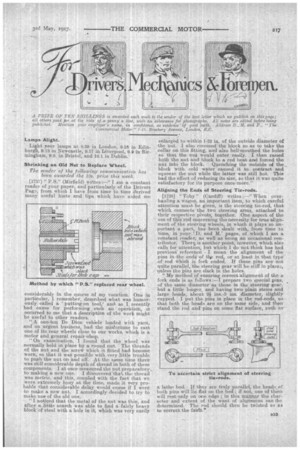A PRIZE OF TEN SHILLINGS is awarded each week to
Page 21

If you've noticed an error in this article please click here to report it so we can fix it.
the sender of the best letter which we publish an this page ; all others paid pr. at the rate of a penny a line, with an adloivanee for photographs. All notes are edited before being publiMed. Mention your employer's name, in eonddence, as evidence of good faith, Address D., M. and F. " The ' Commercial Motor." 7115, Rosebery Avenue, London, E.C. •
!Lamps Alight.
Light yeur lamps at 8.59 in London, 9.53 in Edinburgh, 9.18 irk Newcastle, 9.17 in Liverpool, 9.9 in -Birmingham, 9.9. in Bristol, and 19.1 in Dublin.
Shrinking an Old Nut to Replace Wheel.
The sender of the following communication has been awarded the 10s. prize this week.
[1737] " P.S." (Mirfield) writes :r--" am a constant reader of your paper, and particularly of the Drivers Page, from which I have from time to time derived 'many useful hints and tips which have aided me
considerably in the Course of my vocation. One in particular, I remember, described what was humorously called a 'putting-on tool,' and as .I recently had cause for performing such an operation,. it occurred to me that a description of the work might be useful to other readers.
"A ono-ton De Dion vehicle loaded. with yarn, and on urgent business, had the misfortune to cast one of its rear wheels close to our works, which is a motor and general repair 'shop.
"On examination, I found that the wheel was .normally held in place by a round nut. The threads of the nut and the screw which it fitted had become worn, so that it was possible with very little trouble to push the nut on and off. At the. sometime there was still considerable depth-of thread in both of these components. I at once measured the nut preparatory., to making a new one. -I discoveredthat, the thread was metric, and this, cohnled with the fact that we were extremely busy at the time, made it very probable that considerable delay would ensue if I were to make a new nut. I accordingly decided to try to make user of the old one.
• "I noticed that the metal of the nut was thin, and after a little search was able to find a -fairly heavy block•of steel with a hole in it, which was very easily. enlarged to within 1-32 in. of the outside diameter of the nut. I also recessed the block so as to take the collar on this fitting, and also bellinouthed the holes so that the nut would enter easily. I then raised both the nut and block to a red beat and forced the nut into the block. Quenching the outside oi the block With cold water caused it to contract and squeeze the nut while the latter was still hot. This had the effect of reducing its size, so that it was quite satisfactory for its purpose onceimore."
Aligning the Ends of Steering Tie-rods.
[1738] " Toby " (Cardiff) writes':—" When overhauling a Wagon, an important item, to which careful attention must be given, is the steering tie-rod, that which connects the two steering arms, attached to their respective pivots, together. One aspect of the use of this rod concerning the necessity for true alignment of the steering wheels, in which it plays so important a part, has been dealt with, from time to time, in your 'D. and M.' pages, of which I am a constant reader, as well as being an occasional contributor. TheNis another point., however, which also calls for attention, but which I do not think has had previous referenee. I mean the alignment of the. pins in -the ends of the rod., or at least in that type of rod which is fork ended. If those pins are not quite 'parallel, the steering gear will be stiff in places,
• unless the pins are slack in the holes. "My method of ensuring correct alignment of the: e fork ends is as follows :—I prepare two special pins, of the genie diameter as those in the steering gear, bra a little longer-, and having two plain stems and large heads, 'about 2 ins.-3 ins, diameter, slightly cupped. I put the pins in place in the rod-ends, so that both the heads are on the same side, and then stand the rod and pins on some fiat surface, such as
a lathe bed. If they are truly parallel, the heads of both pins will lie flat on the bed; if not, one of them will rest only on one-edge ; in this man_mr the character and extent of the want of .arignment can lbe determined. The rod should then be twisted so as to correct the fault!'






















